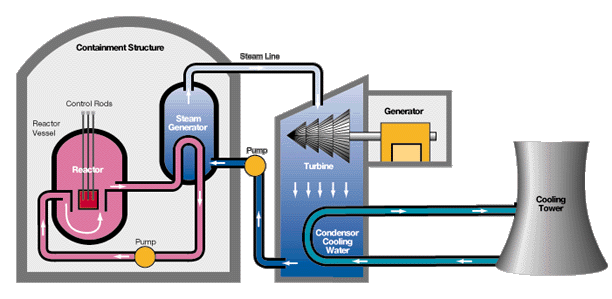Experiment No.: 5
Experiment Name:
Study on different types of Nuclear Reactor used in nuclear power plant.
Objective:
To study on different types of Nuclear Reactor used in nuclear power plant.
Theory:
Nuclear reactor is a device used to initiate and control a fission nuclear chain reaction or nuclear fusion reactions. Nuclear reactors are used at nuclear power plants for electricity generation. Heat from nuclear fission is passed to a working fluid (water or gas), which in turn runs through steam turbines. These turn electrical generators’ shafts and electricity generated.
Types of reactor:
| Boiling Water Reactor (BWR) | Pressurised Water Reactor (PWR) | CANDU | |
| Fuel | Enriched Urenium | Enriched Urenium | Natural Urenium |
| Coolent | Water | Water | D2O |
| Moderator | Water | Water | D2O |
| Control Rod | Cadmium | Cadmium | Cadmium is sandwiched between stainless steel tubes |
Boiling Water Reactor (BWR) : BWR is a type of light water nuclear reactor used for the generation of electrical power. It is the second most common type of electricity-generating nuclear reactor after the pressurized water reactor (PWR), which is also a type of light water nuclear reactor. The main difference between a BWR and PWR is that in a BWR, the reactor core heats water, which turns to steam and then drives a steam turbine. In a PWR, the reactor core heats water, which does not boil. This hot water then exchanges heat with a lower pressure system, which turns water into steam that drives the turbine.
Pressurised Water Reactor (PWR): The PWR also uses ordinary or light water as both coolant and moderator. However in the pressurised water system the cooling water is kept under pressure so that it cannot boil. The PWR differs in another respect from the BWR; the primary coolant does not drive the steam turbine. Instead, heat from the primary water cooling system is captured in a heat exchanger and transferred to water in a secondary system. It is the water in this second system which is allowed to boil and generate steam to drive the turbine.

CANDU: The CANDU (Canada Deuterium Uranium) is a Canadian pressurized heavy-water reactor design used to generate electric power. The acronym refers to its deuterium oxide (heavy water) moderator and its use of (natural) uranium fuel. Fission reactions in the reactor core heat pressurized water in a primary cooling loop. A heat exchanger, also known as a steam generator, transfers the heat to a secondary cooling loop, which powers a steam turbine with an electric generator attached to it. The exhaust steam from the turbines is then cooled, condensed and returned as feedwater to the steam generator. The final cooling often uses cooling water from a nearby source, such as a lake, river, or ocean.

